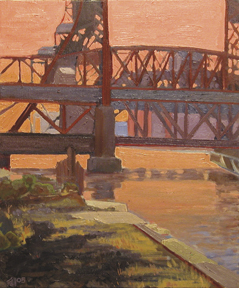A TRELLIS OF SCULPTED STEEL, it straddles the Hackensack and Passaic rivers, reaching desperately across the Meadowlands to make landfall in Jersey City at one end and Newark on the other: the Pulaski Skyway. Is it a bridge only a mother could love? Maybe so, but it’s indisputably our signature emblem of industrial artistry.
Completed in 1933, in America’s heyday of public works, it could be a beneficiary of 2009’s mammoth, economy-stimulating bailout bill.
“The concrete decking is crumbling,” says Steven Hart, author of The Last Three Miles (The New Press, 2007), which documents the skein of circumstances that led to the construction of what came to be known as “Death Avenue.”
Though the decking is “full of holes,” Hart says the bridge “won’t give way. The steel structure is sound, and the lifespan of the Skyway was increased by the banning of trucks.” But that’s not to say that braving the Skyway is a fun ride. “You have to keep your wits about you,” he says. “You don’t feel safe on the rising, falling, undulating roadbed.” The police don’t patrol it, he says, because there’s no place for a vehicle to pull over, so motorists “lead foot” it across.
BUT HART AGREES THAT however decrepit or outmoded, the Skyway has its charms. “It’s attractive,” he says. “From a distance there’s an interesting synthesis—brutal dark material turned into a latticework with a beautiful flow and regularity that moves in an arc across the landscape in an ingenious way that’s pleasing to the eye.” Add poetry to the mix.
What’s underneath is far less aesthetic but no less poetic. “You have a regular, orderly network of steel beams dancing through the air,” he says, “with chaos down below, an absolute jumble of crooked roadways and trailer farms and junkyards—a no man’s land. You can tell a lot about a nation by the way it treats its castoff areas.”
The image of Tony Soprano driving across the Skyway will be forever imprinted on our brains, and indeed the Skyway has been painted, shot, sculpted, stain-glassed, and sketched to within an inch of its life. So we are not alone in seeing art in what Hart describes as a “striking combination of form and function creating an aesthetic with black steel standing tip toe on concrete columns which rise from the mud.”
A truss bridge, the Skyway is supported by a structure composed of rigid steel beams, as opposed to a suspension bridge with cables anchored at both ends. “Everyone loves suspension bridges like the George Washington and Golden Gate,” Hart says, “but to love a truss bridge you have to be an engineering geek. The Skyway is a truss bridge in its most perfect form. It has a Victorian feel to it, so regular, moving harmoniously over a completely chaotic landscape.”
The Skyway was constructed using railroad principles, which accounts for its narrow roadbed. At the time, “no one had experience moving huge volumes of traffic outside the railroad industry, which had the technology that most closely approached what they wanted to do,” Hart says. Now, “development comes up on either side of it, and expanding it would present technical challenges.”
The condition of the concrete, the narrow roadbed which would be hard to widen, and questions about whether it will be a recipient of infrastructure spending have caused some to wonder if the Skyway should be torn down. “It would be a challenge to replace it, just as the original design was a great challenge, Hart says. “It would be an aesthetic loss to the area. It’s a monument to the crucial turning point in American history when America was transformed from a train to an automobile nation.”—Kate Rounds
